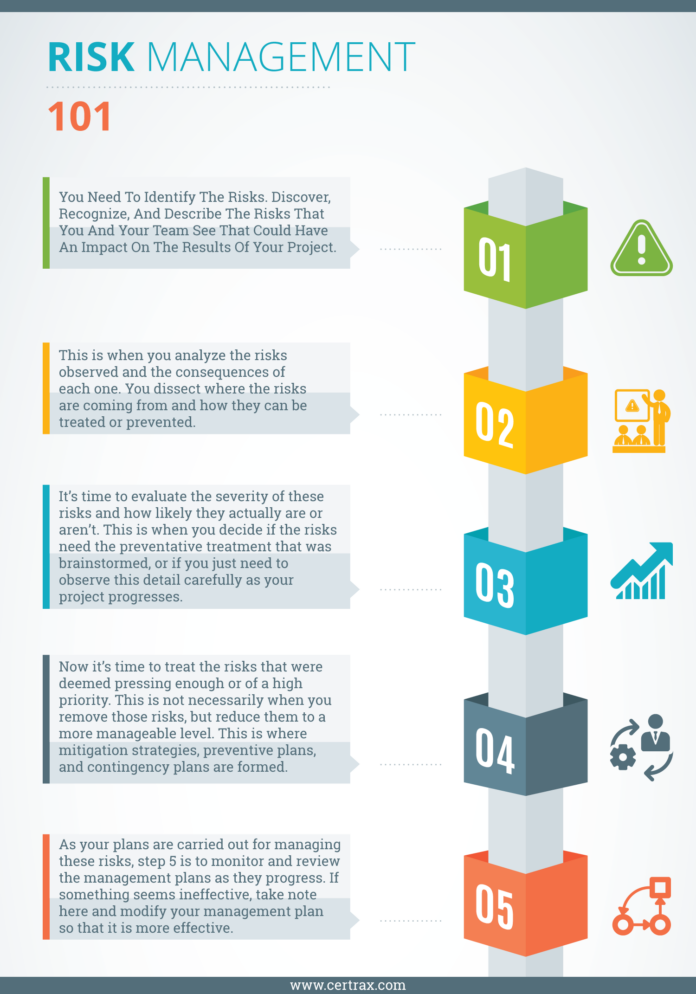Free Download Project Risk Management Plan Example PDF
What’s the Risk?
Risk is defined as an event that has a probability of occurring, and could have either a positive or negative impact on a project should that risk occur. A risk may have one or more causes and, if it occurs, one or more impacts.
For example, a cause may be requiring an environmental permit to do work or having limited personnel assigned to design the project. The risk event is that the permitting agency may take longer than planned to issue a permit, or the assigned personnel available and assigned may not be adequate for the activity.
If either of these uncertain events occurs, there may be an impact on the project cost, schedule, or performance. All projects assume some element of risk, and it’s through risk management that tools and techniques are applied to monitor and track those events that have the potential to impact the outcome of a project.
What’s the Risk Management?
Risk management is an ongoing process that continues through the life of a project.
It includes processes for risk management
- Planning,
- Identification,
- Analysis,
- Monitoring,
- And control.
Many of these processes are updated throughout the project lifecycle as new risks can be identified at any time. It’s the objective of risk management to decrease the probability and impact of events adverse to the project. On the other hand, any event that could have a positive impact should be exploited.
The identification of risk normally starts before the project is initiated, and the number of risks increases as the project matures through the lifecycle. When a risk is identified, it’s first assessed to ascertain the probability of occurring, the degree of impact on the schedule, scope, cost, and quality, and then prioritized.
Risk events may impact only one or while others may impact the project in multiple impact categories. The probability of occurrence, the number of categories impacted and the degree (high, medium, low) to which they impact the project will be the basis for assigning the risk priority. All identifiable risks should be entered into a risk register and documented as a risk statement.
As part of documenting a risk, two other important items need to be addressed.
The first is mitigation steps that can be taken to lessen the probability of the event occurring.
The second is a contingency plan, or a series of activities that should take place either prior to, or when the event occurs.
Mitigation actions frequently have a cost. Sometimes the cost of mitigating the risk can exceed the cost of assuming the risk and incurring the consequences. It is important to evaluate the probability and impact of each risk against the mitigation strategy cost before deciding to implement a contingency plan. Contingency plans implemented prior to the risk occurring are pre-emptive actions intended to reduce the impact or remove the risk in its entirety. Contingency plans implemented after a risk occurs can usually only lessen the impact.
Identifying and documenting events that pose a risk to the outcome of a project is just the first step. It is equally important to monitor all risks on a scheduled basis by a risk management team and reported on them in the project status report.
Purpose Project Risk Management Plan
This plan documents the processes, tools, and procedures that will be used to manage and control those events that could have a negative impact on the Insert Project Name Here project. It’s the controlling document for managing and controlling all project risks.
This plan will address:
- Risk Identification
- Risk Assessment
- Risk Mitigation
- Risk Contingency Planning
- Risk Tracking and Reporting
How to Create a Risk Management Plan
Risk Management is a big topic. But at its core is your risk management plan… How will you deal with a particular risk?
Eight Steps to Create a Risk Management Plan
1-Clarify what the risk is
Characterize it, describe it, evaluate it, for:
- Impact
- Likelihood
- Proximity (time)
2-Understand root causes
3-Split it into smaller risks if possible For each
4-Determine how you will respond, strategically
You can choose one or more from:
- Eliminate
- Reduce likelihood
- Reduce impact
- Transfer
- Create a contingency plan
- Accept (and do nothing more)
5-For each strategy, determine the tactics and approaches you can take. Evaluate them and document the best
6-Write up your action plan.
Include:
- What you will do
- Timing (schedule)
- Who will be responsible
- Resources they will need (people, assets, and materials)
- Budget
- Review points
7-Determine residual risk If you follow your action plan, what, if any, risk remains?
8-Document further contingency plans, if needed, to handle the realization of this residual risk.


